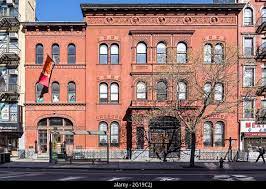Stuyvesant Polyclinic

The Stuyvesant Polyclinic was built in 1883-84 and designed by William Schickel. It was sold to a German Polyklinik in 1906 and added to the National Register of Historic Places in 1979. It features a beautiful exterior with sculpted portrait busts of notable physicians. Among these prominent physicians are William Harvey, an English physiologist, and Carolus Linnaeus, a Swedish botanist.
Stuyvesant Polyclinic was built in 1883-84
Initially built as a library, Stuyvesant Polyclinic served the Lower East Side and the East Village. By 1954, the facility was serving 6 million patients annually. After a number of renovations and additions, the facade was painted white. In 1886, an article in the New York Times reported that up to 25 percent of the building’s 24,000 books were in German.
Before 1905, the building was known as the German Dispensary. The building features round arched windows and Corinthian columns. The facade of the building is adorned with terra-cotta details. The building’s history is rich in meaning. Its construction and use have made it a landmark of the community. Before 1905, it was used as a medical clinic for German immigrants on the Lower East Side.
In mid-2005, a Villager reporter reported that the clinic was looking for a buyer. By July 2006, it had sold for $7 million. In January 2007, new plans were revealed for the clinic’s building. The first floor would become condominiums, while the second and third floors would be converted into student dormitories. In September 2007, the clinic finally sold for $7 million and moved out.
It was designed by William Schickel
The Stuyvesant Polyclinic Hospital is a building located at 137 Second Avenue in Manhattan. Designed in 1884, it was built by German architect William Schickel for the city’s German immigrants. It features a classical, ornate design with sculpted portrait busts of famous physicians including William Harvey, an English physiologist, Carolus Linnaeus, and Friedrich von Humboldt, a German naturalist.
In the late 1880s, Schickel’s ‘Stuyvesant Polyclinic’ was a unique building, featuring Gothic-style arches and intricate details. This building’s interior was designed to be both welcoming and calming. In the late 1800s, the clinic housed doctors, nurses, and students. The building was also designed to accommodate an expansion of the library, and in recent years has been a hub of co-working for entrepreneurs and other businesses.
Earlier in his career, Schickel designed several religious buildings, including St. Liborius Roman Catholic Church in St. Louis, the Catholic Clubhouse on West 59th Street in New York City, and the palatial townhouse of John D. Crummins, Esq. in Manhattan. Schickel’s work is still prominent, but it’s important to note that the Stuyvesant Polyclinic was also designed by another prominent American architect, William F. B. Owing to its history, the building is a cultural landmark and a popular tourist destination.
It was sold in 1906 to German Polyklinik
The original Stuyvesant Polyclinic was built in 1883-84 as a branch of the New York Free Circulating Library. The hospital was affiliated with the German Hospital, uptown (now Lenox Hill Hospital), and served the Little Germany neighborhood of Lower Manhattan. In 1906, the hospital was sold to the German Polyklinik and renamed Stuyvesant Polyclinic. Despite the name change, the original buildings were renovated numerous times and were added to the National Register of Historic Places in 1979.
It was added to the National Register of Historic Places in 1979
The Giant Forest Lodge and Camp Kaweah Historic District are both listed on the National Register of Historic Places. It was also added to the National Register of Historic Places in 1979. The Generals Highway Stone Bridges and Moro Rock Stairway are listed on the list as well. These structures were originally built during the Gold Rush in California. They were designated as national historic landmarks in 1978 by the National Park Service.
Nominations are reviewed by the State Historic Preservation Commission (SHRC). The committee will decide whether a property meets the criteria for the list. Once the SHRC makes its final decision, the nomination is sent to the state historic preservation office, which will make the final decision within 45 days. The final decision is made by the Keeper of the National Register in Washington D.C. It is important to remember that the nomination process is very lengthy.




